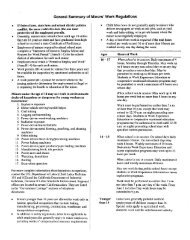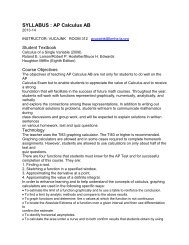SYLLABUS : AP Calculus BC
SYLLABUS : AP Calculus BC
SYLLABUS : AP Calculus BC
Create successful ePaper yourself
Turn your PDF publications into a flip-book with our unique Google optimized e-Paper software.
<strong>SYLLABUS</strong> : <strong>AP</strong> <strong>Calculus</strong> <strong>BC</strong><br />
2013-14<br />
INSTRUCTOR: VUCAJNK ROOM 312 avucajnk@bmhs-la.org<br />
Student Textbook<br />
<strong>Calculus</strong> of a Single Variable (2006)<br />
Roland E. Larson/Robert P. Hostetler/Bruce H. Edwards<br />
Houghton Mifflin (Eighth Edition)<br />
Course Objectives<br />
The objectives of teaching <strong>AP</strong> <strong>Calculus</strong> <strong>BC</strong> are not only for students to do well on the<br />
<strong>AP</strong><br />
<strong>Calculus</strong> Exam but to enable students to appreciate the value of <strong>Calculus</strong> and to receive<br />
a strong<br />
foundation that will facilitate in the success of future math courses. Throughout the year,<br />
students will work with functions represented graphically, numerically, analytically, and<br />
verbally<br />
and explore the connections among these representations. In addition to writing out<br />
mathematical solutions to problems, students will learn to communicate mathematics<br />
during<br />
class discussions and group work, and will be expected to explain solutions in written<br />
sentences<br />
on various homework, test and quiz questions.<br />
Technology<br />
The teacher uses the TI83 graphing calculator. The TI83 or higher is recommended.<br />
Graphing calculators are allowed and in some cases required to complete homework<br />
assignments. However, students are allowed to use calculators on only about half of the<br />
test and<br />
quiz questions.<br />
There are four functions that students must know for the <strong>AP</strong> Test and for successful<br />
completion of this course. They are:<br />
1. Finding a root.<br />
2. Sketching a function in a specified window.<br />
3. Approximating the derivative at a point.<br />
4. Approximating the value of a definite integral.<br />
In order to enhance learning and to help understand the concepts of calculus, graphing<br />
calculators are used in the following specific ways:<br />
• To estimate the limit of a function graphically and to use a table to reinforce the conclusion.<br />
• To find a limit by analytic methods and compare to the above results.<br />
• To graph functions and determine the x values at which the function is not continuous<br />
• To locate the Absolute Extrema of a function over a given interval and then use differentiation<br />
to<br />
confirm the estimate.<br />
• To identify horizontal asymptotes.<br />
• To calculate the area under a curve and to both confirm results that students obtain by using
Riemann sums and by using antiderivatives.<br />
• To evaluate definite integrals for functions that are difficult to solve analytically.<br />
• To graph a function and determine whether it is one to one<br />
on its entire domain.<br />
• To graph a function and approximate the zeroes for functions whose zeroes are difficult to find<br />
analytically.<br />
• To graph the region bounded by the graphs of two or more functions.<br />
• To draw a slope field for differential equations by picking, for example, 8 points such as<br />
(0,0),(0,1),(1,0) etc.<br />
• To obtain slopes at these points by using the differentiation capabilities of the calculator.<br />
The above calculator activities are done using exponential, polynomial, trigonometric,<br />
logarithmic and piecewise<br />
functions. Students are encouraged to use calculators often to<br />
develop familiarity and learn its strengths and weaknesses.<br />
Course Outline:<br />
<strong>AP</strong> <strong>Calculus</strong> AB Review Topics:<br />
Chapter 1 Limits and Their Properties<br />
2. Finding Limits Graphically and Numerically<br />
3. Evaluating Limits Analytically<br />
4. Continuity and One Sided Limits<br />
5. Infinite Limits<br />
Chapter 2 Differentiation<br />
1. The Derivative and the Tangent Line Problem<br />
2. Basic Differentiation Rules and Rates of Change<br />
3. Product and Quotient Rules and HigherOrder<br />
Derivatives<br />
4. The Chain Rule<br />
5. Implicit Differentiation<br />
6. Related Rates<br />
Chapter 3 Applications of Differentiation<br />
1. Extrema on an Interval<br />
2. Rolle’s Theorem and the Mean Value Theorem<br />
3. Increasing and Decreasing Functions and the First Derivative Test<br />
4. Concavity and the Second Derivative Test<br />
5. Limits at Infinity<br />
6. A Summary of Curve Sketching<br />
7. Optimization Problems<br />
8. Newton’s Method<br />
9. Differentials
Chapter 4 Integration<br />
1. Antiderivatives and Indefinite Integration<br />
2. Area<br />
3. Riemann Sums and Definite Integrals<br />
4. The Fundamental Theorem of <strong>Calculus</strong><br />
5. Integration by Substitution<br />
6. Numerical Integration<br />
Chapter 5 Logarithmic, Exponential, and Other Transcendental Functions<br />
1. The Natural Logarithmic Function: Differentiation<br />
2. The Natural Logarithmic Function: Integration<br />
3. Inverse Functions<br />
4. Exponential Functions: Differentiation and Integration<br />
5. Bases Other Than e and Applications<br />
6. Inverse Trigonometric Functions: Differentiation<br />
7. Inverse Trigonometric Functions: Integration<br />
Chapter 6 Differential Equations<br />
1. Slope Fields and Euler’s Method<br />
2. Differential Equations: Growth and Decay<br />
3. Separation of Variables and the Logistic Equation<br />
Chapter 7 Applications of Integration<br />
1. Area of a Region Between Two Curves<br />
2. Volume: The Disk Method<br />
4. Arc Length and Surfaces of Revolution<br />
New Topics:<br />
Chapter 8 Integration Techniques, L’Hopital’s Rule, and Improper Integrals<br />
1. Basic Integration Rules<br />
2. Integration by Parts<br />
3. Trigonometric Integrals<br />
4. Trigonometric Substitution<br />
5. Partial Fractions<br />
6. Integration by Tables and Other Integration Techniques<br />
7. Indeterminate Forms and L’Hopital’s Rule<br />
8. Improper Integrals<br />
Chapter 9 Infinite Series<br />
1. Sequences<br />
2. Series and Convergence<br />
3. The Integral Test and pSeries<br />
4. Comparisons of Series<br />
5. Alternating Series
6. The Ratio and Root Tests<br />
7. Taylor Polynomials and Approximations<br />
8. Power Series<br />
9. Representation of Functions by Power Series<br />
10. Taylor and Maclaurin Series<br />
Chapter 10 Conics, Parametric Equations, and Polar Coordinates<br />
1. Conics and <strong>Calculus</strong><br />
2. Plane Curves and Parametric Equations<br />
3. Parametric Equations and <strong>Calculus</strong><br />
4. Polar Coordinates and Polar Graphs<br />
5. Area and Arc Length in Polar Coordinates<br />
Vectors handout<br />
Please obey the following rules:<br />
-ALWAYS BE ON TIME<br />
-DON’T BE ABSENT FROM CLASS UNLESS ABSOLUTELY NECESSARY<br />
-NO FOOD OR DRINKS IN CLASS<br />
-FOLLOW ALL BMHS POLICIES<br />
GRADING PERCENTAGES:<br />
20% HOMEWORK<br />
20% QUIZZES<br />
40% TESTS<br />
20% FINAL<br />
HOMEWORK:<br />
Homework is assigned daily and it is due next class. If a student does not have the homework<br />
he or she receives 0.There is no homework makeup so it is important that every homework is<br />
done. This policy will never change.<br />
If a student is absent then the homework is due within 2 days upon return. The student is<br />
responsible for turning the homework in. If the homework is not turned in within 2 days by the<br />
student the grade is 0.<br />
QUIZZES:
There will be random amount of quizzes administered at random times. Quizzes will not be<br />
announced in advance so students have to be prepared at all times for a quiz.<br />
EXAMS:<br />
In general there will be one exam per chapter. Exams will be announced at least a day in<br />
advance.<br />
IF A STUDENT IS ABSENT DURING AN EXAM OR A QUIZ HE OR SHE IS RESPONSIBLE<br />
FOR A MAKE UP WITHIN 3 DAYS UPON RETURN.IF THE EXAM OR A QUIZ IS NOT MADE<br />
UP, THE GRADE IS 0.<br />
FINAL:<br />
There is a comprehensive final exam at the end of each semester<br />
NAME:___________________________--<br />
SIGNATURE:_________________________________







